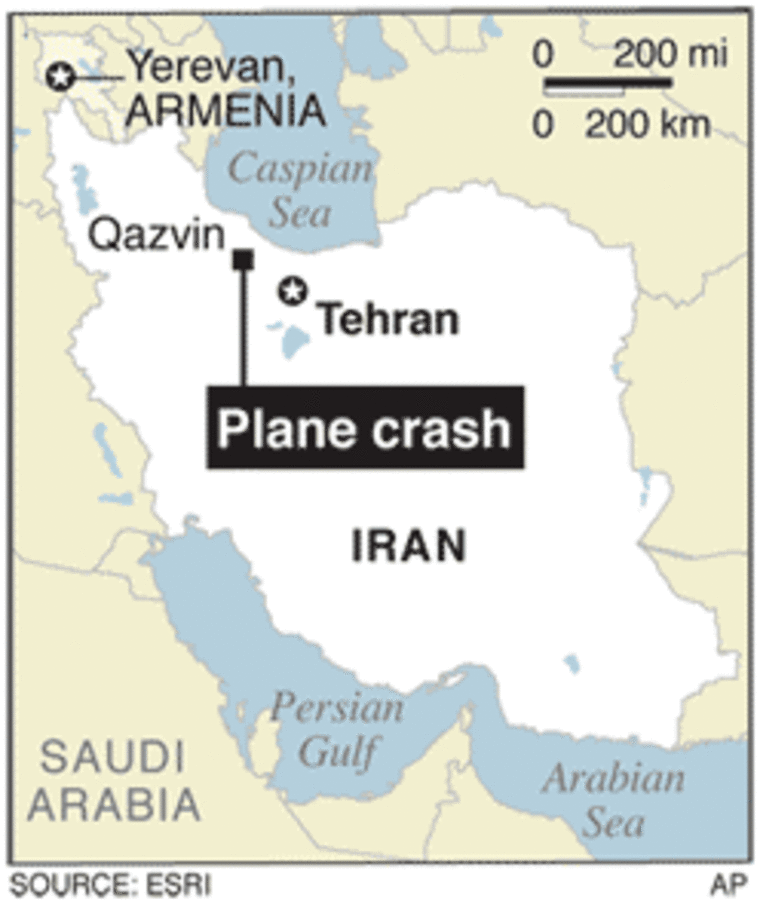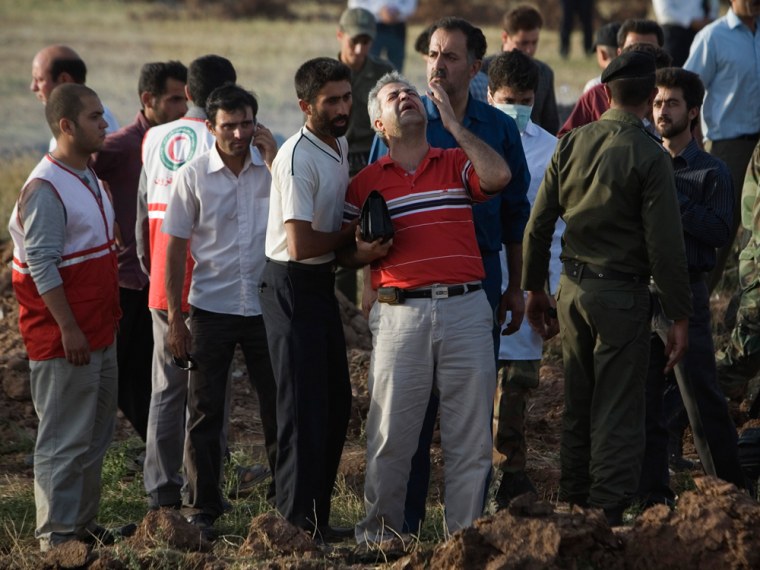Investigators have recovered two of the three black boxes belonging to a Russian-made jetliner that crashed shortly after taking off from Tehran, Iran's state radio reported Thursday.
All 168 people aboard the Caspian Airlines aircraft bound for Yerevan, Armenia, on Wednesday were killed.
The radio's report quoted chief investigator Ahmad Majidi as saying one of the two recovered boxes was damaged. It said the boxes — the plane's cockpit voice and flight data recorders — would likely be sent to the aircraft's Russian manufacturers for analysis.
The search for the third black box was continuing, Majidi said.
Bodies of the victims would be taken to Tehran later Thursday for identification, he added.
Most of the passengers were Iranians, many of them from Iran's large ethnic Armenian community, as well as 11 members of Iran's national youth judo team. Five Armenian citizens were among the dead, Armenia's Foreign Ministry said in a statement, along with two Georgians, including a staffer from the Caucasus nation's embassy in Yerevan.
Armenia on Thursday announced a one-day national state of mourning to mark the death of its citizens in the crash, according to the Russian news agency ITAR-Tass.
Aging fleet
Reporting from Yerevan, the agency said flags would fly at half-mast on government buildings and Armenian embassies abroad. Local radio and TV have canceled entertainment programs in a show of respect, it said.
The crash was the latest in a string of air disasters in recent years that have highlighted Iran's difficulties in maintaining its aging fleet of planes.
Iranian airlines, including state-run ones, are chronically strapped for cash, and maintenance has suffered, experts say. U.S. sanctions prevent Iran from updating their 30-year-old American aircraft and make it difficult to get European spare parts or planes. The country has come to rely on Russian aircraft, many of them Soviet-era planes that are harder to get parts for since the Soviet Union's fall.
Witnesses said the plane's tail was on fire before it went down, plowing a deep, long trench into agricultural fields outside the village of Jannat Abad, and the aircraft was blasted to bits.
'Big explosion'
Flaming wreckage, body parts and personal items were strewn over a 200-yard area. Firefighters put out blazes from the crash, but smoke smoldered from the pit for hours after as emergency workers searched for data recorders and other clues to the cause.
Ali Akbar Hashemi, a 23-year-old, was laying gas pipes in a house by the field when he saw the stricken jet overhead. He said the plane was circling in the air, flames shooting from its tail section.
"Then, I saw the plane crashing nose-down. It hit the ground causing a big explosion. The impact shook the ground like an earthquake," Hashemi told The Associated Press by phone.
The Tu-154M jet had taken off from Tehran's Imam Khomeini International Airport. It crashed at 11:30 am, about 16 minutes after takeoff, outside Jannat Abad, near the city of Qazvin, around 75 miles northwest of Tehran, civil aviation spokesman Reza Jafarzadeh told state media.
At Yerevan's airport, Tina Karapetian, 45, sobbed and said she had been waiting for her sister and the sister's 6- and 11-year-old sons, who were due on the flight.
"What will I do without them?" she cried before collapsing to the floor.
The cause of the crash was not immediately known.
Serob Karapetian, the chief of Yerevan airport's aviation security service, said the plane may have attempted an emergency landing, but reports that it caught fire in the air were "only one version." He did not elaborate. A police officer told Iran's semi-official ISNA news agency that several witnesses reported seeing the plane's tail on fire.

The Tupolev's three engines are in its tail section. The flames there could indicate "an uncontained engine failure," said Patrick Smith, a pilot and the air travel and safety writer for Salon.com.
But he said it's too early to tell. The crash's root cause could be elsewhere, and the flames a sign of a compressor stall caused when the plane went out of control, interrupting airflow through the engine, Smith said.
The crash is Iran's worst since February 2003, when a Russian-made Ilyushin 76 carrying members of the elite Revolutionary Guards crashed in the mountains of southeastern Iran, killing 302 people aboard. That crash was a sign of how maintenance problems have also affected Iran's military.
Caspian Airlines is an Iranian-Russian private joint venture founded in 1993, with a fleet of Tu-154s built between 1989 and 1993. Russia produced 900 Tu-154s until production was halted in 1996.
More on Iran
